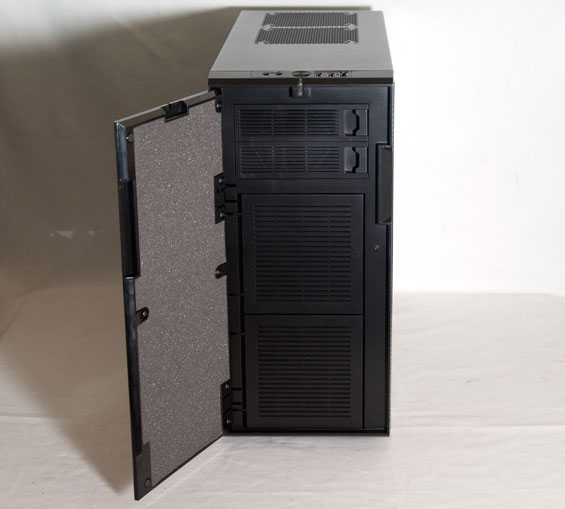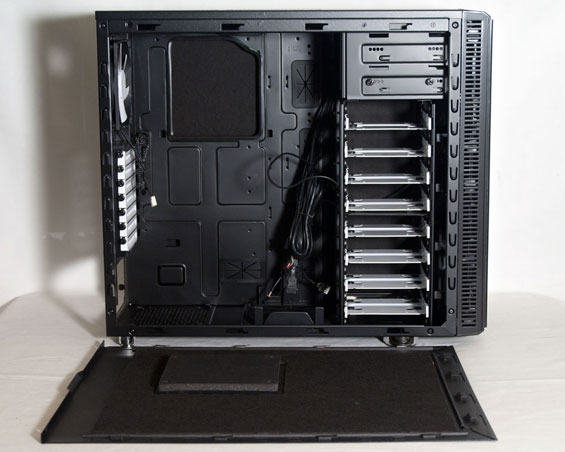Fractal Design Define R3: A Fan Favorite Keeps the Noise Down
by Dustin Sklavos on November 11, 2011 1:22 AM EST- Posted in
- Cases/Cooling/PSUs
- mid-tower
- Fractal Design
In and Around the Fractal Design Define R3
If you read our review of the Fractal Design Arc Midi, the Define R3's interior is going to seem pretty familiar. That's not necessarily a bad thing; Fractal Design brings a lot of smart ideas to the table with the two enclosures, and the R3 in particular seems to really maximize its internal real estate compared to some of the competition. It's not a big case, but there's a lot to it.

Before we get to that, though, the basics: the R3 uses a foam-padded door on the front to keep the noise in, but unlike Antec's older P180 series designs, Fractal Design wisely places the power button and I/O ports at the top of the enclosure, above the door. The result is a door that becomes less of a nuisance and more functional. When you open it, you'll find the two 120mm fan mounts (one of which is occupied) as well as just two 5.25" drive bays. Some users might chafe at the notion of being stuck with just two bays, but I honestly prefer it for most enclosures. Surrounding the door on the outside is a ventilated region that allows the intake fan to pull in air from the sides; this is an improvement over NZXT's H2, whose door threatens to completely suffocate the intakes, but it feels minimal compared to the intakes in Antec's P180 series.
The sides and bottom of the enclosure are pretty much what you've come to expect, with two fan mounts on the top, one on the side, and one on the bottom, but the difference here is that every mount but the bottom one is basically sealed off with removable acoustic foam panels. This honestly feels like such a good idea that I'm baffled as to why it's not more common, because it basically allows the R3 to succeed either as a quiet case or as a performance case (provided you add additional fans), as well as offering several points in between. I love it, and I wish more enclosure designers would implement something like this. Moving around to the back of the enclosure we see Fractal Design's traditional set of white expansion slot covers and the white exhaust fan, but otherwise nothing particularly noteworthy.

When you pop the R3 open, though, you'll see an interior that's largely well designed and really maximizes the available space. A friend of mine is in the market for a new case, and when I showed her the R3 she actually called the eight drive trays "extravagant." That may very well be, but they're an appreciated amount of expansion (even if a touch excessive), and the lateral mounting allows for easy cable routing to behind the motherboard tray. Fractal Design also includes the usual grommet-lined holes for cable routing, but they're a touch smaller in the R3. As for expansion clearance, odds are you're not going to be fitting an AMD Radeon HD 6990 or ASUS Mars II in here, but if you can afford either of those, why are you buying a $100 case? I found the clearance for power supplies, expansion cards, and CPU cooling to be just right.
Fractal Design has also padded both side panels, a much appreciated gesture keeping in line with the R3's ambitions as a silent chassis.
Ultimately I'm a fan of the R3's aesthetics (particularly the blue LED at the top center of the case that goes up and around the power button), and it's been my experience that a lot of you also like these generally sleek, minimalistic designs. The good news I have for you is that you've spoken and it seems the vendors are listening, given what Fractal Design is doing, along with BitFenix and some others. Even a recent conversation with Antec about the upcoming P280 suggests you're being heard loud and clear.
















83 Comments
View All Comments
icebox - Friday, November 11, 2011 - link
Thanks. I suppose the Q6600 generates quite some heat by itself? Since a fusion /atom board would be cool enough and I have wd green drives for the build it should work quite nice than.Thanks for the detailed info.
slacr - Friday, November 11, 2011 - link
Yes, it runs at ~60-80W i'd assume, on slightly lower voltage than stock.The entire system consumes 100-120W measured at the socket. To clarify, the front fans slot in between the drive cage and the front of the case and do not affect the space for disks. It should work fine with lots WD GP-drives.
Peskarik - Friday, November 11, 2011 - link
I have this case since 2 days.There is space for 2 intake fans independent of number of drives you put in. Moreover you have a hole at the bottom, a hole on the left side, two holes on the top = building well-cooled (but maybe loud) machine is no problem.
j-g-faustus - Friday, November 11, 2011 - link
I'm using this case for a home server with ten HDD (using all eight 3.5" and both 5.25" bays) and a i7 920, it works very well.I had to experiment a bit with cooling, but with a few extra fans it is both cool and quiet.
More detail here: http://www.silentpcreview.com/forums/viewtopic.php...
TerdFerguson - Friday, November 11, 2011 - link
"odds are you're not going to be fitting an AMD Radeon HD 6990 or ASUS Mars II in here, but if you can afford either of those, why are you buying a $100 case?"Are you really that out of touch with reality? A computer case, to many, is a plain metal box that sits tucked away under a desk. Being able to accommodate a slightly larger than average graphics card does not alone justify a huge price bump.
You guys are quick to do teardowns of every Apple or Amazon branded product you can get your hands on, why don't you do some on high-end computer cases and motherboards. Please, please, please, show us where all the extra money is being converted into value. I would be very interested in hearing how profit margins scale against unit price. Until that's been done, please stop coming off as a snobby douche-bag by insinuating that a case that costs less than $100 is inappropriate for housing a high-end graphics card.
Dustin Sklavos - Friday, November 11, 2011 - link
Did you not read my review?In my experience, the only place you're going to find both silence AND cooling performance in an enclosure is north of the $150 mark or so. I've been testing these for the better part of the last year and the fact is, depending on your priorities, you DO get what you pay for by spending up on something like SilverStone's FT02, Antec's P183, or Thermaltake's Level 10 GT.
Or you could just insult me. You could do that, too.
JarredWalton - Friday, November 11, 2011 - link
Thanks for the reply, Terd, but are *you* that out of touch with reality? The number of people who buy/own the 6990 and/or Mars II is so trivially small that what we're saying is the <0.01% of users who own one of those products will want a larger case and aren't interested in a $100 enclosure.Let's see... $700+ on the graphics card, $200+ for a PSU to run the cards, and certainly you'd want a good motherboard and CPU in there. But after all that, you seem to think people would go for a $100 "box of steel" to put it in. I've got a 5870 CrossFire setup myself, and originally had it in a Lian Li case that's similar in some ways to this; I upgraded to a Silverstone case and a different motherboard purely to make the system run cooler and better. You want to run something like that in the Fractal Design, sure, you can do it; you can even do GTX 580 SLI. But if you're after an HD 6990 (http://www.newegg.com/Product/Product.aspx?Item=N8... or a crazy-extreme Mars II (like this one: http://www.newegg.com/Product/Product.aspx?Item=N8... I'm pretty sure this case isn't in contention for the rights of holding everything.
JonnyDough - Saturday, November 12, 2011 - link
Jarred, I believe that many people have spent a lot on their essential components and not had much left over for a case. Its one area where I would personally be willing to cut corners. $100 will get me more than a suitable box. Just because I may want a fast PC (My Opteron 185 was once bleeding edge), does not mean I need to invest a lot in a case and I believe there are many sensible people who would share that sentiment.I have spent $400 on a graphics card before. I don't know why anyone would though, when you can simply wait a year and buy a $180 graphics card that outperforms it. Seems like that $200 could make me an extra $200 by the time I retire, and then I'd be happy to say I saved up to $400 by waiting a year and going lower-end. Computers today are "fast enough" and just because you can't play the latest titles does not mean you won't have solid, tested, cheap entertainment. I know capitalists would like to push sales, but we already live in a debt/slave society. The logical mathematics of it point to the idea that people willing to spend that much on a new system are not good stewards of their money.
7Enigma - Thursday, November 17, 2011 - link
I agree completely with your first statement (I as well looked for a cheap well performing case for both myself and my dad's gaming rigs). The Antec300 in my dad's system is INCREDIBLE for the money. I believe I spent $35 after a 30 rebate or something, WITH free shipping from Newegg, and with a moderate system (core i5 not OC'd, 5850) it is virtually silent with fantastic airflow. Same with my personal gaming system which was a $50-70 sTitan case which similarly performed very well while remaining pretty quiet.I guess a lot of people constantly are modding their systems but for me it's pretty much build it and occasionally take it outside to air compressor clean it, but it stays like that until the next build. So I don't really care if the build itself is a bit difficult, or the case isn't fancy (sits under my desk), it just has to perform well, have good cable routing options, and be inexpensive.
I have no clue, though, where you go off on the second paragraph tangent about our society.
Calin - Friday, November 11, 2011 - link
"but they've driven south the price of acoustically optimized cases"Is that in Mexico, Honduras, or maybe even Argentina?